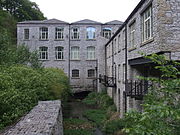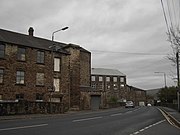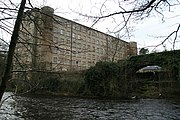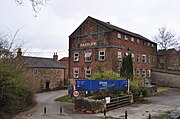This is a list of the cotton and other textile mills in Derbyshire, England. The first mills were built in the 1760s in the Derwent Valley by Arkwright and Strutt, and were powered by the water of the River Derwent. The abundance of water from the River Etherow and its tributaries led to mills being built in Longdendale and Glossopdale, and similarly along the River Wye in Millers Dale. As the industry developed, the mills changed hands, were demolished, were converted to use steam, or consolidated into larger units. They changed their names and their functions. Water-powered mills were smaller than the later steam-powered mills found in Greater Manchester. Parts of Derbyshire have been subsumed into Stockport.
Longdendale
Derwent Valley
- This includes Derby, and Belper
| Name | Architect | Location | Built | Demolished | Served (Years) |
|---|---|---|---|---|---|
| North Mill | Belper 53°01′45″N 1°29′11″W / 53.0291°N 1.4864°W | 1786/1804 | |||
 |
1186846Notes: The original North Mill, completed in 1786 by Jedediah Strutt, was destroyed by fire in 1803. Its replacement was built in 1804 by his son, William Strutt, on the foundations of the old mill and is one of the oldest surviving examples of an iron-framed 'fire-proof' building in the world. [1] | ||||
| East Mill | Belper 53°01′44″N 1°29′09″W / 53.0288°N 1.4857°W | 1912 | Standing | 112 | |
 |
1336982Notes: A fortress-like, seven-storey building, 24 bays by 11, with four corner turrets with Italianate tower, it was constructed by the English Sewing Cotton Company in 1912. [1] | ||||
| Round Mill | Belper 53°01′41″N 1°29′11″W / 53.0280°N 1.4865°W | 1816 | 208 | ||
| Notes: Demolished; designed for bale-breaking. | |||||
| West Mill | Belper 53°01′42″N 1°29′12″W / 53.0284°N 1.4866°W | 1797 | 227 | ||
| Notes: Demolished. | |||||
| 2nd South Mill | Belper 53°01′42″N 1°29′12″W / 53.0284°N 1.4866°W | 1811 | 213 | ||
| Notes: Demolished. | |||||
| Junction Mill | Belper 53°01′42″N 1°29′12″W / 53.0284°N 1.4866°W | ||||
| Notes: Demolished. | |||||
| Reeling Mill | Belper 53°01′42″N 1°29′12″W / 53.0284°N 1.4866°W | 1807 | 217 | ||
| Notes: Demolished. | |||||
| de Bradelei Mill | Belper 53°01′18″N 1°29′06″W / 53.0216°N 1.4849°W | ||||
| Notes: George Brettle & Co., makers of hosiery. [2] | |||||
| Unity Mill | Derwent St, Belper 53°01′25″N 1°29′10″W / 53.0236°N 1.4861°W | mid 19th century | |||
| 1087354Notes: A corn mill converted to cotton spinning by John Strutt (1853), then furniture manufacture. [2] | |||||
| 1850 Gritstone warehouse | Belper | ||||
| Notes: The Ward, Sturt and Sharp hosiery warehouse from 1850. [2] | |||||
| Boar's Head Cotton Mills | Darley Abbey 52°56′38″N 1°28′28″W / 52.9438°N 1.4745°W | 1782-1862 | |||
 |
Notes: The Evans Mills produced high-quality 'Boar's Head' sewing cotton. Long Mill was built in 1782, operational in 1788, then burnt down in 1789 and was rebuilt in 1790. The top floor was used as a schoolroom for their child workers. It connects to West Mill (1821), Middle Mill (1804–05) and East Mill (1811). Separate is a Gassing Shed (1862) where the thread was singed, and the North Mill (1835). The free-standing engine house has been demolished but the chimney remains. [3] | ||||
| Cromford Mill | Cromford 53°06′31″N 1°33′21″W / 53.1085°N 1.5557°W | 1771 | |||
 |
1248010Notes: The first cotton mill set up by Richard Arkwright to use the "Spinning Jenny" to make cotton thread. Later a paint factory. | ||||
| Bath Street Mill | Derby | 1851 | 173 | ||
 |
Notes: | ||||
| Queen Street Mill | Derby | ||||
| Lombe's Mill | Derby | 18th century | |||
 |
Notes: | ||||
| Masson Mill | Matlock Bath 53°06′44″N 1°33′44″W / 53.1121°N 1.5621°W | 1783 | 241 | ||
 |
Notes: | ||||
| Milford Mills | Milford 53°00′18″N 1°28′53″W / 53.0049°N 1.4813°W | ||||
 |
Notes: The Milford mill complex, built by Jebediah and William Strutt, spanned the A6 toll road, upstream from Milford bridge. Started in the 1780s to spin cotton, it expanded to include bleaching and dyeing mills. William built the warehouse in 1793, experimenting to produce a multi-storey fire-proof mill.The extant dyehouse near the bridge was a later more successful attempt. [4] | ||||
River Wye
| Name | Architect | Location | Built | Demolished | Served (Years) |
|---|---|---|---|---|---|
| Cressbrook Mills | Cressbrook SK173726 53°15′00″N 1°44′31″W / 53.250°N 1.742°W | 1815 | 209 | ||
 |
1158897Notes: [5] | ||||
| Litton Mill | Millersdale SK161729 53°15′11″N 1°45′36″W / 53.253°N 1.760°W | ||||
 |
Notes: [5] | ||||
| Lumford Mill | Bakewell 53°13′05″N 1°41′01″W / 53.2180°N 1.6836°W | ||||
 |
Notes: | ||||
| Rowsley Mill | |||||
The mills of New Mills and Rowarth
| Name | Architect | Location | Built | Demolished | Served (Years) |
|---|---|---|---|---|---|
| St. George's Works (Wellington New Mill) | [6] | ||||
| Grove Paper Mill | 53°21′44″N 2°00′23″W / 53.3621°N 2.0065°W | ||||
| Ned Mill | [6] | ||||
Rowarth Brook
| Name | Architect | Location | Built | Demolished | Served (Years) |
|---|---|---|---|---|---|
| Top Mill | Rowarth [6] | ||||
| Grove Mill | Rowarth | ||||
| Notes: A print works [5] [6] | |||||
| Froggatt's Mill | Rowarth [6] | ||||
| Lower Mill | Rowarth [6] | ||||
| Little Mill | Rowarth SK011889 53°23′49″N 1°59′06″W / 53.397°N 1.985°W | 1930 | 94 | ||
| Notes: The oldest-known mill in the New Mills area, built between the inn and the brook. It was a two-storey building powered by a waterwheel. The remains were swept away by the flood of 18 June 1930. [5] [6] | |||||
| Ringstones (Alma Mount) | Rowarth [6] | ||||
| Bate Mill | Thornsett SK007868 53°22′41″N 1°59′28″W / 53.378°N 1.991°W | ||||
| Notes: 1889: bleachers and dyers [6] [7] | |||||
River Goyt
| Name | Architect | Location | Built | Demolished | Served (Years) |
|---|---|---|---|---|---|
|
Torr Vale Mill aka Stafford's Mill Lowe's Mill |
The Torrs, New Mills SJ999854 53°21′53″N 2°00′11″W / 53.3648°N 2.0030°W | 1788 | **** | 212 | |
 |
1119721Notes: [6] | ||||
|
Torr Mill, a.k.a. Schofield's Mills |
The Torrs, New Mills 53°21′50″N 2°00′01″W / 53.3640°N 2.0002°W | 1838 | 1912 | 74 | |
| Notes: Spindleage: (1811) 14 mules, 2802 spindles, (1848) 20 mules, 13,792 spindles, boiler by Butterley. The first mill was built in 1794 by Samuel Schofield, for cotton spinning. It was powered by water. It was burnt down on 22 October 1838 while being operated by John Sheldon. The second bigger five-storey mill was built immediately on the same site. A chimney was added in 1846, suggesting that this mill was operated by steam and water. The mill was occupied by Josiah Mellor and John Roberts until 1857, when it passed to Messrs Hibbert and Alcock cotton spinners. In June 1873, the mill was floated with capital of £4000 as a co-operative venture known as the Torr Mill Spinning Company. In 1883 a new boiler was installed. The mill became unviable in 1900 and the machinery was removed. Two further firms attempted to use the mill but it was destroyed by fire on 2 December 1912. The leat for this mill passed under the Queens Road bridge and in a trough over the River Sett, and the tail race continued downstream under the Union Road bridge. Torrs Hydro has been built on the site. [6] [8] [9] | |||||
| Rock Mill, a.k.a. Crowther's Mill | The Torrs, New Mills, 53°21′54″N 2°00′08″W / 53.3650°N 2.0022°W [6] | ||||
| Hague Bar (Hague/Haigh) Mill | [6] | ||||
| Strines Printworks | Strines, Marple, 53°22′35″N 2°02′23″W / 53.3765°N 2.0396°W [6] | ||||
River Sett
- Also known as River Kinder.
| Name | Architect | Location | Built | Demolished | Served (Years) |
|---|---|---|---|---|---|
| Hyde Bank (Beard) (Goddard Mill) | Hide Bank, New Mills SK001856 53°22′01″N 2°00′00″W / 53.367°N 2.000°W | 1785 | Standing | 239 | |
 |
Notes: The first mill was a woollen mill which burnt down. This four-storey gritstone former cotton mill, on Hyde Bank Road straddling the River Sett, dates from the early 19th century. The mill used to be a finishing mill for W S Lowe & Sons, but has been shut for a number of years. It has now been converted into flats and the bridge on the left is a recent replacement. The first cotton spinning mill was constructed in 1785; before that an early woollen and fulling occupied the site. Now in multiple occupation. [6] [10] | ||||
| Birch Vale Printworks | SK 020868 53°22′41″N 1°58′16″W / 53.378°N 1.971°W, [6] | ||||
| Garrison Works | Thornsett, SK 015869 53°22′44″N 1°58′44″W / 53.379°N 1.979°W [6] | ||||
London Place (Watford Bridge Printworks) |
Sett Valley SK 005863 53°22′26″N 1°59′38″W / 53.374°N 1.994°W | ||||
| Notes: 1889: calico printing. [6] [7] | |||||
| Salem (Bower) Mill | SK002858 53°22′08″N 1°59′53″W / 53.369°N 1.998°W | ||||
| Notes: Two-storey gritstone buildings, formerly a cotton mill of the 1780s and later a chemical works. Next to the medieval manorial corn mill. [6] | |||||
| Barnes Top Shop (Torr Top Mill) (Midland Ironworks) | [6] | ||||
| Grove (Wyatt's) (Barnes) Mill | [6] | 1790 | 76 | ||
Peak Forest Canal
| Name | Architect | Location | Built | Demolished | Served (Years) |
|---|---|---|---|---|---|
| Brunswick Mill/Works | Newtown, New Mills SJ997849 53°21′40″N 2°00′22″W / 53.361°N 2.006°W | ||||
 |
Notes: Three- and four-storey gritstone mill building (datestone 1883) on the Peak Forest Canal. Formerly a cotton mill, bought in 1868 by the Quaker, Edward Godward 1841–1908, who became the first chairman of New Mills UDC, in 1894. Spindleage 1887: 11,000 kitting and sewing cottons. It was extended and used as a sweet factory by Swizzels Matlow. [5] [6] [7] | ||||
| Victoria Mill | Newtown, New Mills | 1860 | 125 | ||
 |
Notes: 1889: Josseph Froggatt & Son, 1,000 spindles. Victoria Mill was built in 1860 and when it closed in 1985 was the last cotton spinning mill to work in New Mills. It was partly destroyed by fire on 13 March 1986 and has subsequently been largely demolished. There is a picture of it just after the fire on the front of New Mills – A look back at its Industrial Heritage (1997). [6] [7] | ||||
| Woodside (New Brunswick) Mill | Newtown, New Mills [6] | ||||
| Albion Mill | Newtown, New Mills SJ996848 53°21′36″N 2°00′25″W / 53.360°N 2.007°W | ||||
 |
Notes: Three- and four-storey gritstone mill building of 1859. This was the first of a group of mid-19th century cotton mills erected around the Peak Forest Canal. [5] [6] | ||||
| Warks Moor Mill | Newtown, New Mills | ||||
| Notes: 1889: Francis Rowbottom, 8000 spindles [6] [7] | |||||
| Redmoor Mill | Newtown, New Mills [6] | ||||
| Albert Mill | Newtown, New Mills | ||||
| Notes: 1889:Bleachers and Dyers and paper maker [6] [7] | |||||
| Some of these mills are occupied by Swizzels Matlow. [11] One mill was built about 1843, and part was destroyed by fire in 1983. Swizzels Matlow's address is Albion Road. | |||||
Other
| Name | Architect | Location | Built | Demolished | Served (Years) |
|---|---|---|---|---|---|
| Brunt Mill | Longnor, SK085646 53°10′41″N 1°52′26″W / 53.178°N 1.874°W [12] [5] | ||||
| Calver Mill | Calver SK 247745 53°16′01″N 1°37′52″W / 53.267°N 1.631°W | 1804 | Standing | 119 | |
 |
1068650Notes: The mill opened in 1778, built by John Gardom of Bakewell and John Pares of Leicester on the site of a corn mill. To use Arkwright's two patents there was an initial premium of £7000 and an annual royalty of £1000. By 1785, the mill had been developed and stood at three storeys. In 1799, however, the River Derwent washed away Calver Bridge and took part of the mill with it; shortly after the mill was burned to the ground. A new seven-storey mill was subsequently constructed, and began production in 1804. By 1830 it employed 200 workers some being parish apprentices. In 1833 new, larger, waterwheels were constructed. [13] Spinning finished in 1923. In the 1980, the mill featured in Pat Reid's television drama Colditz, standing in for Colditz Castle. [14] [5] | ||||
| Clough Mill | Little Hayfield SK032882 53°23′28″N 1°57′11″W / 53.391°N 1.953°W | ||||
 |
Notes: A former water-powered and later steam-powered textile mill. Converted to apartments in 1989. [5] | ||||
| Edale Mill | Edale SK 134854 53°21′54″N 1°48′00″W / 53.365°N 1.800°W | 1795 | Standing | 139 | |
 |
1096614Notes: This mill has now been converted into apartments. The first mill was a corn mill driven by the River Noe. In 1795 Nicholas Cresswell enlarged the building, taking James Harrison, Robert Blackwell and Joseph Fletcher as partners. A three-storey building with external stair column, the present mill was added a little later. The mill which passed to the Fine Spinners & Doublers Ltd, and cotton manufacturing ceased here in 1934. Many of the women workers came from Castleton, walking to the mill via Hollins Cross at a height of 1,250 feet (380 m). This was a climb of 650 feet (200 m); during bad weather they would sleep at the mill. [5] [15] | ||||
| Haarlem Mill | Derby Rd, Wirksworth | 1780 | Standing | 244 | |
 |
1335116Notes: Cotton spinning mill erected by Richard Arkwright | ||||
| Hayfield Fulling Mill | Hayfield, SK055863 53°22′26″N 1°55′08″W / 53.374°N 1.919°W [5] | ||||
| Lumb Mill Lambs Hole |
Kettleshulme, SJ 988804 53°19′16″N 2°01′08″W / 53.321°N 2.019°W [5] | ||||
| Phoside Mill | Hayfield SK037859 53°22′12″N 1°56′46″W / 53.370°N 1.946°W | ||||
 |
Notes: [5] | ||||
| Primrose Mill | Hayfield, SK031880 53°23′20″N 1°57′18″W / 53.389°N 1.955°W [5] | ||||
| Walk Mill | Hayfield, SK037870 53°22′48″N 1°56′46″W / 53.380°N 1.946°W [5] | ||||
References
- ^ a b Belper & The Strutts: The Mills
- ^ a b c Derwent Valley Mills Heritage Walks Leaflet, Belper Historical Society, 2006
- ^ Derwent Valley Mills Heritage Walks Leaflet, Darley Abbey Historical Group, 2006
- ^ On site interpretative panel
- ^ a b c d e f g h i j k l m n o "Derbyshire and Peak District Mills". Derbyshire Heritage. 2009. Retrieved 2 December 2009.
- ^ a b c d e f g h i j k l m n o p q r s t u v w x y z aa ab Lewis, Steve. "Industrial Development in New Mills". Retrieved 29 November 2009.
- ^
a
b
c
d
e
f Worrall, John (1887).
Cotton Spinners and Manufacturers Directory. Oldham. p. 179. Retrieved 9 December 2009.
{{ cite book}}: CS1 maint: location missing publisher ( link) - ^ Brumhead, Derek (Autumn 1988). "Commenting on Advert;Stockport Advertiser 1848" (PDF). New Mills Historical Society Journal (1). New Mills Historical Society: 12, 13. Retrieved 26 November 2009.[ permanent dead link]
- ^ Steven Lewis web page,
- ^ "NEW MILLS - Old New Mills & Hayfield".
- ^ Swizells Matlow literacy exercise Archived 26 January 2009 at the Wayback Machine
- ^ Caudwell Land
- ^ Cooper, Brian (1983). Transformation of a Valley: The Derbyshire Derwent. London: Heinemann. p. 99. ISBN 9780435329730.
- ^ Cooper 1983, p. 101.
- ^ Cooper 1983, pp. 102–6.
External links
-
 Media related to
Textile mills in Derbyshire at Wikimedia Commons
Media related to
Textile mills in Derbyshire at Wikimedia Commons
